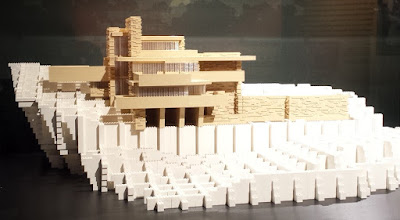Last week, I spent two days in Chicago doing an unofficial architectural tour.
The trip was inspired by a desire to visit Frank Lloyd Wright's Robie House near the University of Chicago in Hyde Park. Anyone who knows me, knows I have distinct interest in all of Wright's work—in the past I've visited, and blogged about, Taliesin, Taliesin West and Falling Water.
Robie House was built in 1910, and is the pinnacle of Wright's prairie style homes. Long lines and low ceilings allow the structure to fit into it's natural landscape. Yet, in response to a desire for privacy and protection (the owner had young children), the home has almost a fortress like feel from the outside.
Touring it, I didn't feel the floorplan flowed as smoothly as some of Wrights other homes. I'm wondering if that was because certain portions of the home weren't open to the public, or if this winding path was part of the home's original design.
Nevertheless, it is an undeniably Wright space, and when renovations are complete, it will be a masterful piece of architecture history.
Just down the road, I saw another Wright masterpiece — at the Museum of Science and Industry. This one was much smaller...
The Fallingwater model at the Brick by Brick Lego architecture exhibit was built by Adam Reed Tucker and contains some 21,000+ bricks.
The Brick by Brick exhibit is a special feature at the museum running through February 2017. Other highlights include a 60 foot long Golden Gate Bridge (64,500 bricks) and a replica of the Palace of Fine Arts (18,500 bricks) — the building the museum is actually in!
 Coincidentally, at the recommendation of a friend, I had started listening to Devil in the White City by Erik Larson on my drive to Chicago. The book is about the murders that took place during the 1893 World's Columbian Exposition in Chicago; with a second, parallel storyline about the architects behind the expo, Burnham and Root. While reading about the process of building this Expo, it was amazing to be standing in the only building remaining from the event. It was an unplanned and absolutely kismet scenario.*
Coincidentally, at the recommendation of a friend, I had started listening to Devil in the White City by Erik Larson on my drive to Chicago. The book is about the murders that took place during the 1893 World's Columbian Exposition in Chicago; with a second, parallel storyline about the architects behind the expo, Burnham and Root. While reading about the process of building this Expo, it was amazing to be standing in the only building remaining from the event. It was an unplanned and absolutely kismet scenario.*
Burnham and Root were to come up again on day two of my architectural adventures. The pair of architects achieved great success after the 1871 Chicago Fire. Otis's invention of the safety elevator and the strength of new steel construction, made it possible to design taller buildings. Burnham and Root are credited with the first "skyscraper" — built in 1882 (demolished in 1902), the Montauk was 10 stories tall.
Just down the street from where the Montauk once stood, is the Rookery building. Also designed by Burnham and Root (their office was on the top floor), the Rookery is an 11 story tall steel building on LaSalle, in the "Loop" of downtown Chicago.
Built in 1888, the main entry to the building opens up to the Light Court, a glass covered courtyard. In 1905, the building's owners hired Frank Lloyd Wright to update and modernize the Light Court.
To brighten the space, Wright covered the original dark cast iron ornamentation with white marble with gold Persian style inlays, which was more in unison with the other materials within the building. The original design still hides under the marble casing today.
The Rookery's Light Court is Wright's only work within the downtown landscape of Chicago. You can tour the light court as part of the Frank Lloyd Wright Foundation.
From the Rookery, I headed north to the Chicago River and got aboard my Wendella boat** for a 75 minute architectural tour. It was a beautiful 90+ degree afternoon, and we had a lovely ride down the river, which has seen much improvement over the last few year's as part of Chicago's Riverwalk project.

The tour was full of factoids about the buildings along the river, as well as Chicago history in general. In retrospect, I should have trusted my gut and gone with the Chicago Architecture Foundation's 90 minute boat tour. It was a little more expensive, but I think the tour information would have been more geared towards specific architectural details, and construction facts, vs. which building Lady Gaga has a penthouse in. Nevertheless, it was a beautiful ride.
As an amateur architecture buff, I had a fantastic 2 days exploring (and reading about!) this historic city. If your interested in seeing some of what I saw, here's all the details:
- Robie House Tour – 5757 S. Woodlawn Ave.
$17 dollar tour - Brick by Brick – Science and Industry Museum – 5700 S. Lake Shore Dr.
$18 museum entry + $9 for special exhibit
Exhibit showing until September 2017
Parking - $22 (Robie house is .7 miles away, I parked in the residential neighborhood for free and walked to the museum).
(Don’t miss Colleen Moore's Fairy Castle!!) - Rookery Tour – 201 S. LaSalle St.
$7 for a 30 minute tour
If you go on a Wednesday, you can also tour Burnham's Library! - Wendella's Original Architecture Tour – 401 N. Wabash Ave.
5 minute boat ride for $35
*This book is amazing. Highly recommend.
**At the Trump Dock. Which made me cringe. I hope they're not associated.
I did enjoy my fellow passengers taking selfies flipping-off the Trump sign.
I did enjoy my fellow passengers taking selfies flipping-off the Trump sign.














How did you enjoy the selfies of the Trump sign?
ReplyDeleteyou missed "flipping-off" in that sentence
ReplyDelete